+ Open data
Open data
- Basic information
Basic information
| Entry | Database: PDB / ID: 7dxg | |||||||||||||||
|---|---|---|---|---|---|---|---|---|---|---|---|---|---|---|---|---|
| Title | Structure of SAR7334-bound TRPC6 at 2.9 angstrom | |||||||||||||||
 Components Components | Short transient receptor potential channel 6 | |||||||||||||||
 Keywords Keywords | MEMBRANE PROTEIN / TRPC6 / TRPC / FSGS / SAR7334 / channel | |||||||||||||||
| Function / homology |  Function and homology information Function and homology informationpositive regulation of ion transmembrane transporter activity / slit diaphragm / negative regulation of dendrite morphogenesis / Role of second messengers in netrin-1 signaling / store-operated calcium channel activity / Effects of PIP2 hydrolysis / Elevation of cytosolic Ca2+ levels / inositol 1,4,5 trisphosphate binding / positive regulation of calcium ion transport / cation channel complex ...positive regulation of ion transmembrane transporter activity / slit diaphragm / negative regulation of dendrite morphogenesis / Role of second messengers in netrin-1 signaling / store-operated calcium channel activity / Effects of PIP2 hydrolysis / Elevation of cytosolic Ca2+ levels / inositol 1,4,5 trisphosphate binding / positive regulation of calcium ion transport / cation channel complex / actinin binding / clathrin binding / TRP channels / monoatomic cation transport / regulation of cytosolic calcium ion concentration / single fertilization / monoatomic cation channel activity / positive regulation of neuron differentiation / calcium ion transmembrane transport / calcium channel activity / cellular response to hydrogen peroxide / neuron differentiation / positive regulation of cytosolic calcium ion concentration / ATPase binding / actin binding / cellular response to hypoxia / protein homodimerization activity / membrane / plasma membrane / cytoplasm Similarity search - Function | |||||||||||||||
| Biological species |  Homo sapiens (human) Homo sapiens (human) | |||||||||||||||
| Method | ELECTRON MICROSCOPY / single particle reconstruction / cryo EM / Resolution: 2.9 Å | |||||||||||||||
 Authors Authors | Chen, L. / Guo, W. | |||||||||||||||
| Funding support |  China, 4items China, 4items
| |||||||||||||||
 Citation Citation |  Journal: Neuron / Year: 2022 Journal: Neuron / Year: 2022Title: Structural mechanism of human TRPC3 and TRPC6 channel regulation by their intracellular calcium-binding sites. Authors: Wenjun Guo / Qinglin Tang / Miao Wei / Yunlu Kang / Jing-Xiang Wu / Lei Chen /  Abstract: TRPC3 and TRPC6 channels are calcium-permeable non-selective cation channels that are involved in many physiological processes. The gain-of-function (GOF) mutations of TRPC6 lead to familial focal ...TRPC3 and TRPC6 channels are calcium-permeable non-selective cation channels that are involved in many physiological processes. The gain-of-function (GOF) mutations of TRPC6 lead to familial focal segmental glomerulosclerosis (FSGS) in humans, but their pathogenic mechanism remains elusive. Here, we report the cryo-EM structures of human TRPC3 in both high-calcium and low-calcium conditions. Based on these structures and accompanying electrophysiological studies, we identified both inhibitory and activating calcium-binding sites in TRPC3 that couple intracellular calcium concentrations to the basal channel activity. These calcium sensors are also structurally and functionally conserved in TRPC6. We uncovered that the GOF mutations of TRPC6 activate the channel by allosterically abolishing the inhibitory effects of intracellular calcium. Furthermore, structures of human TRPC6 in complex with two chemically distinct inhibitors bound at different ligand-binding pockets reveal different conformations of the transmembrane domain, providing templates for further structure-based drug design targeting TRPC6-related diseases such as FSGS. | |||||||||||||||
| History |
|
- Structure visualization
Structure visualization
| Movie |
 Movie viewer Movie viewer |
|---|---|
| Structure viewer | Molecule:  Molmil Molmil Jmol/JSmol Jmol/JSmol |
- Downloads & links
Downloads & links
- Download
Download
| PDBx/mmCIF format |  7dxg.cif.gz 7dxg.cif.gz | 590.4 KB | Display |  PDBx/mmCIF format PDBx/mmCIF format |
|---|---|---|---|---|
| PDB format |  pdb7dxg.ent.gz pdb7dxg.ent.gz | 477.5 KB | Display |  PDB format PDB format |
| PDBx/mmJSON format |  7dxg.json.gz 7dxg.json.gz | Tree view |  PDBx/mmJSON format PDBx/mmJSON format | |
| Others |  Other downloads Other downloads |
-Validation report
| Summary document |  7dxg_validation.pdf.gz 7dxg_validation.pdf.gz | 2.5 MB | Display |  wwPDB validaton report wwPDB validaton report |
|---|---|---|---|---|
| Full document |  7dxg_full_validation.pdf.gz 7dxg_full_validation.pdf.gz | 2.6 MB | Display | |
| Data in XML |  7dxg_validation.xml.gz 7dxg_validation.xml.gz | 92.6 KB | Display | |
| Data in CIF |  7dxg_validation.cif.gz 7dxg_validation.cif.gz | 125.4 KB | Display | |
| Arichive directory |  https://data.pdbj.org/pub/pdb/validation_reports/dx/7dxg https://data.pdbj.org/pub/pdb/validation_reports/dx/7dxg ftp://data.pdbj.org/pub/pdb/validation_reports/dx/7dxg ftp://data.pdbj.org/pub/pdb/validation_reports/dx/7dxg | HTTPS FTP |
-Related structure data
| Related structure data |  30908MC  7dxbC  7dxcC  7dxdC  7dxeC  7dxfC M: map data used to model this data C: citing same article ( |
|---|---|
| Similar structure data |
- Links
Links
- Assembly
Assembly
| Deposited unit | 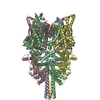
|
|---|---|
| 1 |
|
- Components
Components
-Protein , 1 types, 4 molecules ABCD
| #1: Protein | Mass: 106453.242 Da / Num. of mol.: 4 Source method: isolated from a genetically manipulated source Source: (gene. exp.)  Homo sapiens (human) / Gene: TRPC6, TRP6 / Production host: Homo sapiens (human) / Gene: TRPC6, TRP6 / Production host:  Homo sapiens (human) / References: UniProt: Q9Y210 Homo sapiens (human) / References: UniProt: Q9Y210 |
|---|
-Non-polymers , 6 types, 40 molecules 



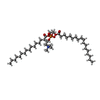






| #2: Chemical | ChemComp-ZN / #3: Chemical | ChemComp-CA / #4: Chemical | ChemComp-Y01 / #5: Chemical | ChemComp-HOR / #6: Chemical | ChemComp-POV / ( #7: Chemical | ChemComp-98R / [( |
|---|
-Details
| Has ligand of interest | Y |
|---|
-Experimental details
-Experiment
| Experiment | Method: ELECTRON MICROSCOPY |
|---|---|
| EM experiment | Aggregation state: PARTICLE / 3D reconstruction method: single particle reconstruction |
- Sample preparation
Sample preparation
| Component | Name: human transient receptor potential channel 6 tetramer / Type: COMPLEX / Entity ID: #1 / Source: RECOMBINANT |
|---|---|
| Source (natural) | Organism:  Homo sapiens (human) Homo sapiens (human) |
| Source (recombinant) | Organism:  Homo sapiens (human) Homo sapiens (human) |
| Buffer solution | pH: 7.5 |
| Specimen | Embedding applied: NO / Shadowing applied: NO / Staining applied: NO / Vitrification applied: YES |
| Vitrification | Cryogen name: ETHANE |
- Electron microscopy imaging
Electron microscopy imaging
| Experimental equipment |  Model: Titan Krios / Image courtesy: FEI Company |
|---|---|
| Microscopy | Model: FEI TITAN KRIOS |
| Electron gun | Electron source:  FIELD EMISSION GUN / Accelerating voltage: 300 kV / Illumination mode: FLOOD BEAM FIELD EMISSION GUN / Accelerating voltage: 300 kV / Illumination mode: FLOOD BEAM |
| Electron lens | Mode: BRIGHT FIELD |
| Image recording | Electron dose: 50 e/Å2 / Film or detector model: GATAN K2 SUMMIT (4k x 4k) |
- Processing
Processing
| CTF correction | Type: NONE |
|---|---|
| 3D reconstruction | Resolution: 2.9 Å / Resolution method: FSC 0.143 CUT-OFF / Num. of particles: 82862 / Symmetry type: POINT |
 Movie
Movie Controller
Controller












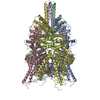
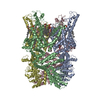
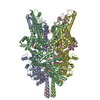
 PDBj
PDBj






